High Speed Pulsed DC TIG Welding Keeps Rifle Production on Target
Barrett Firearms keeps pace with worldwide-demand for its .50 cal. rifle by increasing productivity 45 percent after switching to the Dynasty 350’s advanced technology.
Ronnie Barrett defied conventional wisdom when he created the first shoulder-fired .50 caliber rifle in 1982. The weapon delivered about four times the energy of a standard Springfield .30-06 round (the most popular deer hunting caliber) and is effective out to 2,000+ yards.
People said a weapon that powerful couldn’t be shoulder-fired, but Barrett proved them wrong, designing a unique muzzle brake and inertia absorbing system that dissipated 69.8 percent of the felt recoil. Barrett’s first model, built on the gravel floor of his garage, gave way to numerous upgrades and modifications over the years. His work has made his name synonymous with safety for U.S troops stationed in the Middle East, such as Iraq and Afghanistan. Sports shooting enthusiasts travel from far and wide to participate in 1,000-yard marksmanship competitions based on Barrett’s advancements.
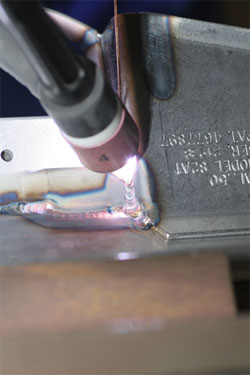 |
|
The high speed pulsing capabilities of the Dynasty 350 AC/DC TIG inverter concentrate and focus the arc cone. This creates a narrow weld bead and increases travel speed while reducing heat input.
|
With fame and growth came expectation. Barrett Firearms (Murfreesboro, Tenn.) was pushed to its manufacturing limits as worldwide demand grew. The company found itself turning away work because it couldn’t add production without sacrificing the quality that is the distinct trademark of a Barrett rifle.
In 2005, Barrett Firearms needed to upgrade from its 20-year-old competitive brand TIG welders, which produced less than ideal arcs. In the short term, the company purchased two Syncrowave® 200 AC/DC TIG welders from Miller Electric Mfg. Co. While those units have been more than serviceable—they had 300,000 arc starts on them in the first 18 months of use—using Syncrowave technology for Barrett’s application was, “sending a boy to do a man’s job,” according to Miller district manager Jim Nye. “Barrett needed the advanced DC TIG pulsing technology incorporated into the Dynasty® 350.”
When most people think of advanced TIG technology, they think of AC welding on aluminum. However, DC TIG applications may also benefit from advanced technology, including those for mild steel and heat-treated steel (Barrett’s two primary materials, in addition to some aluminum), stainless steel, Inconel and highly alloyed metals. High-speed pulsing of the DC TIG arc—at up to 5,000 times per second in some applications—offers many benefits.
After switching to advanced pulsed DC TIG technology, Barrett Firearms increased daily rifle production by 40 to 45 percent and simultaneously improved weld bead quality. Further, the Dynasty 350 slashed primary power consumption by up to 75 percent, which will enable Barrett to add more TIG welders without expensive changes to primary power.
Popular Demand Creates Growth
The cornerstone of Barrett Firearms’ business is the .50 caliber rifle. Much of the company’s expansion resulted from the introduction of new models and accessories (such as optics) that give military personnel, law enforcement agencies, and civilian sport shooters an accurate weapon even at a far distance from its target.
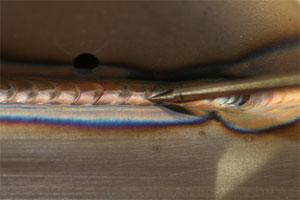 |
|
Notice the narrow heat affected zone (HAZ) created by high speed pulsed TIG, which helps preserve the metal’s original properties.
|
“The .50 caliber rifle gives military personnel the opportunity to fire upon an enemy at a range that most opposing weapons are incapable of reaching,” explains Joey Cannon, welder, Barrett Firearms. “It’s a safety factor for our military. It’s developed for hard targets and can disable vehicles with a single shot from 2,000 meters. You can easily put a round within a ten-inch circle from a thousand yards.” The world record is five shots in less than a 3-in. circle at 1,000 yards (learn more about the rifle’s history and capabilities).
That kind of precision offers no margin-of-error in the fabrication process to weld items such as the rifle’s lower receiver, which is formed from .069 to .100-in. thick sheet metal and heat-treated, .125-in. thick 4140 carbon steel. Each lower receiver is straightened to tolerances within .005-in. over its 36-in. length. The lower receiver cradles the barrel and includes components such as the trigger housing, magazine holder, midlock main spring housing and rear grip.
By early 2007, Barrett realized that it needed to increase welding speed, reduce warping (and the time spent compensating for it) and eliminate cracking that occurs with excess heat input and rapid cooling.
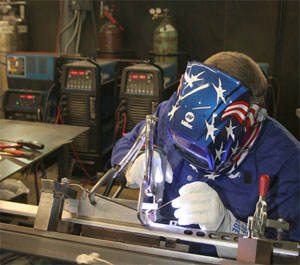 |
|
Barrett Firearms welder Joey Cannon reports that the high speed pulsed DC TIG welding reduced cycle time by 150 seconds and improved overall productivity by up to 45 percent.
|
A lot of our welds encompass thick to thin material in the same pass. To weld successfully, we have to control heat input,” explains Cannon. “Without the ability to control heat over a wide amperage range, we sometimes had to change tungsten or filler diameters. With the Dynasty 350 and pulsed TIG, we don’t have to do that.”
Advanced Pulsed DC TIG Welding
Working with Airgas Mid America account manager Clyde Matthews, Nye explained the benefits of switching to the Dynasty 350.
“Conventional TIG technology can create a wide bead pattern wider than many joints require. A bead that’s wider than necessary puts unneeded heat into the material, and makes it harder to control the weld puddle. Clyde and I showed Barrett’s operators how high speed pulsing would give them control over bead width, increase travel speed and deposition rates and reduce overall heat input.”
With pulsed TIG, the arc pulses between a high peak and low background current. The higher pulsing rates of an advanced TIG inverter increase puddle agitation that produces a better grain molecular structure within the weld. High speed pulsing also constricts and focuses the arc. This increases arc stability, penetration and travel speeds. It also produces a smaller heat-affected zone, eliminating Barrett’s concerns about cracking and warping.
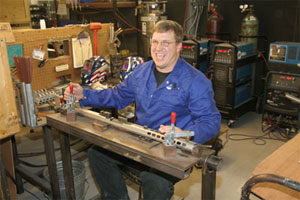 |
|
Barrett Firearms welder Joey Cannon estimates that pulsed DC TIG welding eliminated .025 in. of warping on the rifles lower unit.
|
Pulsed TIG welding requires setting four variables: peak amperage, background amperage, peak time and pulse rate.
Determining good values for setting peak amperage works much the same as setting maximum amperage values for regular DC TIG: use 1 amp for every .001 in. of thickness.
The peak time is simply the percentage of time during one pulsing cycle the power source spends at the peak amperage (main amperage). With peak time of 80 percent and a rate of 1 pulse per second (PPS), the Dynasty will spend 8/10ths of a second at peak amperage and 2/10ths of a second at the background amperage. Increasing the peak time percentage adds more heat to the part, while decreasing peak time percentage reduces heat. Through experimentation, Joey Cannon determined that 80 percent worked well in his application. As general rule of thumb, begin experimenting at 50 to 60 percent peak time.
The background amperage will be a percentage of the main amperage set on the machine. Thus, a machine set for an output of 178 amps and background amperage of 40 percent produces a background amperage output of 71.2 amps. Lowering the background amp percentage reduces the average heat input, while increasing the background amp percentage raises the overall amperage.
 |
|
Setting pulsed DC TIG parameters involves four steps (clockwise from upper left): seat peak amperage at 178, set background amperage at 40 percent of peak, set peak time at 80 percent and set pulsing rate at 170 PPS.
|
When adjusting background current, especially notice how it affects weld puddle fluidity. As a rule, use enough background current to shrink the puddle to about half its normal size while still keeping the puddle fluid. When welding stainless and carbon steels, start by setting the background amperage at 20 to 30 percent of peak amperage.
“By experimenting with pulsing ranges and amperage levels, we determined what worked best for Barrett’s application,” says Airgas’ Matthews. He notes that they only adjusted one variable at a time so that the effect of any adjustment would be clear.
“With the Dynasty 350, we set pulsing parameters that enabled me to run faster yet drop the temperature of each welded part by 75 degrees,” says Cannon. “With standard technology, going ‘faster’ meant putting more heat into the part or using less heat but sacrificing penetration. This new technology allows me to focus the arc, increase amperage, run faster, shrink our heat affected zone—all while maintaining excellent penetration.”
To measure temperature, Cannon used an infrared thermometer. He estimates that reducing heat input by 75 degrees eliminates about .025 in. of warping over the receiver’s 36-in. length. While Barrett, like other quality-oriented manufacturers, straightens all components to maintain consistently tight tolerances, this activity takes time. Thus, high speed pulsed TIG not only reduced welding time by two-and-a-half minutes per receiver, it further lowered cycle time because Barrett spends less time compensating for warping.
Dynasty 350 Adds Power Efficiency, Reliability
The first of the Dynasty 350s that Barrett Firearms put into production struck 65,000 arcs in its first three months. The company has added two more machines since then and looks to add more as demand increases. It recently moved into a new 70,000 sq.-ft. manufacturing facility to make room for growth, but faced the problem of being hamstrung by electrical power to run all of the equipment necessary to streamline production.
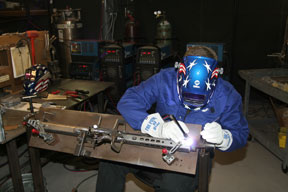 |
|
This fixture rotates so that Barrett welder Joey Cannon can weld in the flat position to maximize productivity. The rotating fixture also improves joint access.
|
“When we weld with our old DC machines at 300 amps, we draw 126 amps from our 230 V, single phase primary line,” says Cannon. “Conversely, these Dynasty 350s only draw 34 amps when welding at 350 amps. I usually run the machine at an average of 120 amps, so we’re probably pulling 5 or 6 amps of primary.”
By switching to the Dynasty 350, Barrett now runs three welders off of the power it previously took to run one welder, and it frees power for other fabricating equipment.
Dynasty inverters use primary power more efficiently than any other AC/DC TIG welder because they feature Auto-Line™ power management technology. In addition to lowering primary power draw, Auto-Line also enables the inverter to run off of any type of primary power, single- or three-phase, from 190 to 630V, which eliminates the need for rewiring. Auto-Line enables companies such as Barrett to retire old welders and add new inverters without changes to primary power—changes that typically cost tens of thousands of dollars.
“When you figure the total cost of everything—from power savings, to reduced warping to a 45 percent production increase, the Dynasty paid for itself within the first week,” says Cannon.
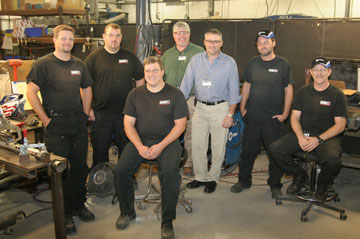 |
|
Barrett Firearms weld shop team includes (from L – R): Steve Cantrell, Addam Burks, Joey Cannon, Lee Minton and Joe Williamson. Also shown are Airgas’ Clyde Matthews (green shirt) Miller’s Jim Nye (blue shirt).
|
“We’re very proud of Barrett rifles and what they’re doing to protect freedom and help law enforcement agencies,” says Ralph Vaughn, business and global brand marketing, Barrett Firearms. “Last year we missed out on some opportunities because we couldn’t increase production. We’ll be reaching those production goals this year, and that translates into profitability for the company. We’re optimistic for the future.”